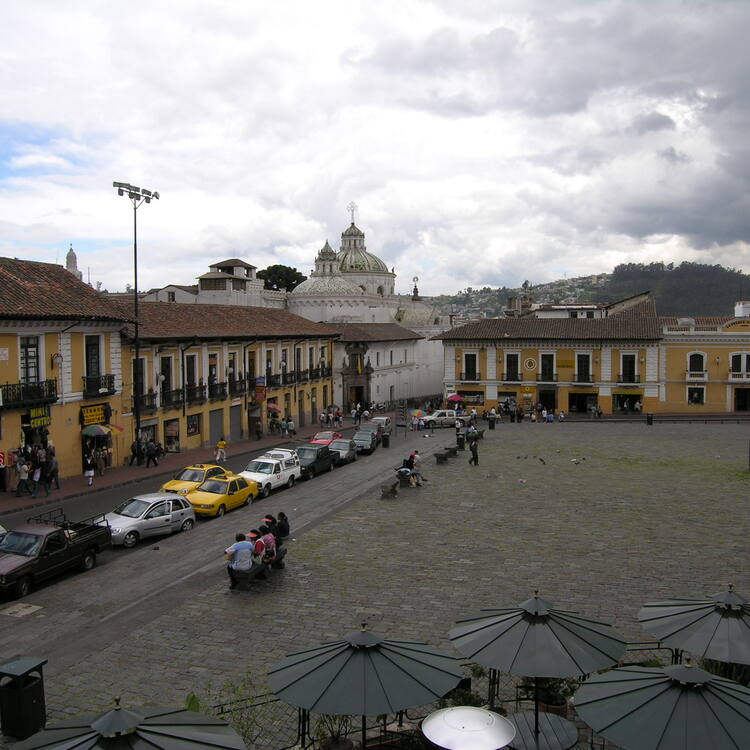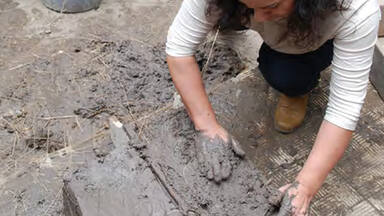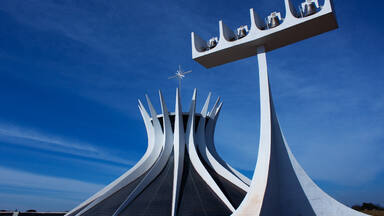City of Quito
City of Quito
Quito, the capital of Ecuador, was founded in the 16th century on the ruins of an Inca city and stands at an altitude of 2,850 m. Despite the 1917 earthquake, the city has the best-preserved, least altered historic centre in Latin America. The monasteries of San Francisco and Santo Domingo, and the Church and Jesuit College of La Compañía, with their rich interiors, are pure examples of the 'Baroque school of Quito', which is a fusion of Spanish, Italian, Moorish, Flemish and indigenous art.
Description is available under license CC-BY-SA IGO 3.0
Ville de Quito
Fondée au XVIe siècle sur les ruines d'une cité inca à 2 850 m d'altitude, la capitale de l'Équateur possède toujours, malgré le tremblement de terre de 1917, le centre historique le mieux préservé et le moins modifié d'Amérique latine. Les monastères San Francisco et Santo Domingo, l'église et le collège jésuite de La Compañía, avec leurs riches décorations intérieures, sont des exemples parfaits de l'« école baroque de Quito », mélange d'art espagnol, italien, mauresque, flamand et indien.
Description is available under license CC-BY-SA IGO 3.0
مدينة كيتو
تأسست عاصمة الإكوادور في القرن السادس عشر على أنقاض إحدى مدن حضارة الإنكا على ارتفاع 2850 متراً وفيها، على الرغم من زلزال العام 1917م،ّ الوسط التاريخي الأفضل حفظاً والأقل تغيّراً في أمريكا اللاتينيّة. وتشكّل أديرة سان فرانسيسكو وسانتو دومينيغو والكنيسة ودير لا كومبانيا اليسوعي بزخارفها الداخليّة الجميلة خير مثال على مدرسة كيتو ذات الطراز الباروكي وهي مزيج بين الفنّ الإسباني والإيطالي والمغربي/الأندلسي والفلمندي والهندي.
source: UNESCO/CPE
Description is available under license CC-BY-SA IGO 3.0
基多旧城
厄瓜多尔的首都基多城海拔2850米,是在16世纪一个印加城市的废墟上建立起来的。尽管历经了1917年的地震,基多仍然是拉丁美洲保存最好、变化最小的历史中心。圣弗朗西斯修道院和圣多明各修道院,拉孔帕尼亚的教堂和耶酥会学院,连同这些建筑华丽的内部装饰都成为了“基多巴洛克风格”的纯正典范,完美地融合了西班牙、意大利、摩尔人式、佛兰德和当地艺术。
source: UNESCO/CPE
Description is available under license CC-BY-SA IGO 3.0
Город Кито
Столица Эквадора Кито была основана в XVI в. на руинах древнего города инков на высоте 2850 м. Несмотря на землетрясение 1917 г., исторический центр Кито является наиболее сохранившимся городом Латинской Америки. Монастыри Сан-Франциско и Санто-Доминго, церковь и колледж иезуитов Ла-Компанья с богатыми интерьерами – все это наглядные примеры "барочной школы Кито", которая является сплавом испанского, итальянского, мавританского, фламандского и местного искусства.
source: UNESCO/CPE
Description is available under license CC-BY-SA IGO 3.0
Ciudad de Quito
Fundada en el siglo XVI sobre las ruinas de una antigua ciudad inca y encaramada a 2.850 metros de altitud, la capital de Ecuador posee el centro histórico mejor conservado y menos alterado de toda América Latina, a pesar del terremoto que la sacudió en 1917. Suntuosamente ornamentados en su interior, los monasterios de San Francisco y Santo Domingo, así como la iglesia y el colegio de la Compañía de Jesús, son un acabado ejemplo del arte de la escuela barroca de Quito, en el que se funden las influencias estéticas españolas, italianas, mudéjares, flamencas e indígenas.
source: UNESCO/CPE
Description is available under license CC-BY-SA IGO 3.0
キト市街
source: NFUAJ
Quito (stad)
Quito is de hoofdstad van Ecuador en werd in de 16e eeuw gesticht op de ruïnes van een Inca stad. De stad ligt op een hoogte van 2.850 meter. Ondanks de aardbeving in 1917 heeft Quito het best bewaarde historische centrum van Latijns-Amerika. De kloosters van San Francisco en Santo Domingo en de kerk en het jezuïetencollege van La Compañia met hun rijke interieurs, zijn pure voorbeelden van de ‘barokschool van Quito’. Dit is een mix van Spaanse, Italiaanse, Moorse, Vlaamse en inheemse kunst. De huizen van Quito zijn voornamelijk gebouwd in de oude Spaanse of Moorse stijl.
Source: unesco.nl
Outstanding Universal Value
Brief synthesis
Isolated in the Andes at 2,818 m. altitude, the city of Quito is spread along the slopes of the Pichincha Volcano and is bordered by the hills of Panecillo and Ichimbia. Founded by the Spanish in 1534, on the ruins of an Inca city, Quito proudly possesses one of the most extensive and best-preserved historic centres of Spanish America.
The city offers a remarkable example of the Baroque school of Quito (Escuela Quitena), that brings together the indigenous and European artistic traditions and which is renowned for providing the greatest contribution of Spanish America to universal art. The height of this art is represented by veritable spiritual citadels, among which are San Francisco, San Domingo, San Augustin, La Compana, La Merced, the Sanctuary of Guapulco and the Recoleta of San Diego, to name just the principal ones. These are recognized not only for their artistic value from the architectural viewpoint but also for their decorative elements (altarpieces, paintings, sculptures).
The city of Quito forms a harmonious ensemble where nature and man are brought together to create a unique and transcendental work. The colonizers knew how to adapt their artistic sensibility to the reality that surrounded them, building their architecture in a very complex topographical environnent. Despite this, the architects were able to confera stylistic and volumetric harmony to the ensemble. The urban routes are based on the original plan and include central and secondary squares as well as checkerboard-patterned streets and are aligned on the cardinal points of the compass. In the city centre, there are convents and churches as well as houses (1 or 2 floors with one or several patios), usually built with earthen bricks and covered with stucco, combining the monumental with the simple and austere.
The city of Quito, the cradle of Pre-Colombian cultures and an important witness of Spanish colonization maintains, for the time being unity and harmony in its urban structure despite centuries of urban development.
Elevated to the title of capital of the Audience of Quito, it assumed the political direction and patronal control over the villages and towns. This is the maximum representation of the step towards forming socio-economic development, creator of a true national idiosyncrasy expressed through its unique tangible and intangible heritage.
Criterion (ii): The influence of the Baroque school of Quito (Escuela Quitena) was recognized in the cultural domain, especially art – architecture, sculpture and painting – in all the cities of the Audencia, and even in those of the neighbouring Audencia.
Criterion (iv): Quito forms a harmonious sui generis where the actions of man and nature come together, to create a unique and transcendental work of its kind.
Integrity
The great majority of attributes upon which the Outstanding Universal Value of the City of Quito is based are present and intact. The Historic Centre of Quito has conserved its original configuration, new constructions being built outside of the colonial centre. Indeed, based on the first plan of Quito designed in 1734 by Dionisio Alcedo y Herrera, one notes that the original plan of the streets, the blocks of houses and squares – with a few rare exceptions – is the same can be seen today.
Despite numerous earthquakes that have affected it over the course of history, the city conserves the least modified historic centre of all Latin America because of the concerted action of the Municipal authorities of the Metropolitan District of Quito and the Ecuadorean government.
Authenticity
In general, the urban plan and its integration into the landscape may be considered as entirely authentic because the original generic form has remained unaltered and the Plaza Mayor (Main Square) has developed organically with very few changes.
The preservation of traditional trades, the contributions of craftsmen holders of ancient know-how and the use of local materials (stone, lime, mud and wood) make it possible to maintain the significant characteristics of the different architectonic components and their decorative elements.
Protection and management requirements
With regard to the legal domain, aspects relating to the protection and safeguarding of cultural heritage are considered in the Constitution of the State, in the Law and Regulations for Cultural Heritage, in the Code of Territorial Organization, Autonomy and Decentralisation (COTAD) and in the Law on Culture which is awaiting approval. The National Institute for Cultural Heritage (INPC) delegates to local governments competences such as the protection and safeguarding of cultural heritage, while reserving the right of control.
The management tools available to the Municipality of the Metropolitan District of Quito are the Territorial Urban Development Plan, the special plan for the Historic Centre of Quito and annual operational plans.
These management tools are planned by the Territorial and Housing Secretariat, while their implementation is the responsibility of the Metropolitan Municipality through the Secretariat of Culture of the Municipality, the Metropolitan Institute of Culture (formerly the Safeguarding Fund for Cultural Heritage), the Administration Zone Centre, the Municipal Development Enterprise and the Commission for Historic Zones, which is the legislator body for the Historic Centre of Quito.
The buffer zone of the Historic Centre as well as its monumental zone share the same legislation that applies to both the conservation and management of the property. These two zones are clearly marked and are covered by specific protection measures. The measures developed to counterbalance the threats and risks affecting the site (earthquakes, volcanic eruptions, parking and traffic problems in the historic zone, etc.) are covered by the Territorial Urban Development Plan and the Special Plan for the Historic Centre of Quito. The Environmental Drainage Programme aims to mitigate land slides and control erosion caused by rainwater, especially during the winter. The revision and application of the collector system for the historic centre has diminished the risks caused by an eruption of the Pichincha Volcano and the overflowing of existing water sources. The boundary of permitted construction zones and the control of illegal constructions on the slopes of Pichincha Volcano aim to lessen the risks for the historic centre and its population. The revision of the transport system and traffic in the Metropolitan District of Quito has led to the introduction of measures to lessen the negative impacts on the historic centre: restriction of the number of public transport lines; installation of a programme of pedestrian streets and bicycle corridors, creation of parking areas in strategic parts of the historic centre.
The importance of measures such as the control of use and activities within the historic centre, the revitalization of public areas that, in 2003, greatly contributed to the conservation of the site and the improvement of the quality of life of its inhabitants, must also be emphasized.

 View photos from OUR PLACE the World Heritage collection
View photos from OUR PLACE the World Heritage collection



